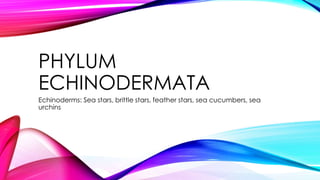Report
Share

Recommended
Recommended
More Related Content
What's hot
What's hot (20)
Phylum Annelida - Class Polychaeta, Class Oligochaeta, Class Hirudinea

Phylum Annelida - Class Polychaeta, Class Oligochaeta, Class Hirudinea
Similar to Echinoderms
Similar to Echinoderms (20)
More from joevani_007
More from joevani_007 (12)
Recently uploaded
Making communications land - Are they received and understood as intended? webinar
Thursday 2 May 2024
A joint webinar created by the APM Enabling Change and APM People Interest Networks, this is the third of our three part series on Making Communications Land.
presented by
Ian Cribbes, Director, IMC&T Ltd
@cribbesheet
The link to the write up page and resources of this webinar:
https://www.apm.org.uk/news/making-communications-land-are-they-received-and-understood-as-intended-webinar/
Content description:
How do we ensure that what we have communicated was received and understood as we intended and how do we course correct if it has not.Making communications land - Are they received and understood as intended? we...

Making communications land - Are they received and understood as intended? we...Association for Project Management
God is a creative God Gen 1:1. All that He created was “good”, could also be translated “beautiful”. God created man in His own image Gen 1:27. Maths helps us discover the beauty that God has created in His world and, in turn, create beautiful designs to serve and enrich the lives of others.
Explore beautiful and ugly buildings. Mathematics helps us create beautiful d...

Explore beautiful and ugly buildings. Mathematics helps us create beautiful d...christianmathematics
Mehran University Newsletter is a Quarterly Publication from Public Relations OfficeMehran University Newsletter Vol-X, Issue-I, 2024

Mehran University Newsletter Vol-X, Issue-I, 2024Mehran University of Engineering & Technology, Jamshoro
Recently uploaded (20)
Russian Escort Service in Delhi 11k Hotel Foreigner Russian Call Girls in Delhi

Russian Escort Service in Delhi 11k Hotel Foreigner Russian Call Girls in Delhi
Making communications land - Are they received and understood as intended? we...

Making communications land - Are they received and understood as intended? we...
Explore beautiful and ugly buildings. Mathematics helps us create beautiful d...

Explore beautiful and ugly buildings. Mathematics helps us create beautiful d...
General Principles of Intellectual Property: Concepts of Intellectual Proper...

General Principles of Intellectual Property: Concepts of Intellectual Proper...
Mixin Classes in Odoo 17 How to Extend Models Using Mixin Classes

Mixin Classes in Odoo 17 How to Extend Models Using Mixin Classes
Unit-IV; Professional Sales Representative (PSR).pptx

Unit-IV; Professional Sales Representative (PSR).pptx
Basic Civil Engineering first year Notes- Chapter 4 Building.pptx

Basic Civil Engineering first year Notes- Chapter 4 Building.pptx
Unit-V; Pricing (Pharma Marketing Management).pptx

Unit-V; Pricing (Pharma Marketing Management).pptx
This PowerPoint helps students to consider the concept of infinity.

This PowerPoint helps students to consider the concept of infinity.
Seal of Good Local Governance (SGLG) 2024Final.pptx

Seal of Good Local Governance (SGLG) 2024Final.pptx
Echinoderms
- 1. PHYLUM ECHINODERMATA Echinoderms: Sea stars, brittle stars, feather stars, sea cucumbers, sea urchins
- 2. CHARACTERISTICS • Radial symmetry • Several arms (5 or more, mostly grouped 2 left- 1 middle- 2 right) radiating from a central body. • Body consist of equal segments, each containing a duplicate of various internal organs.
- 3. CHARACTERISTICS • No brain nor hearts • With eyespots on each arm • Mouth situated on the underside and anus on top (except feather stars, sea cucumbers and some urchins). • Contains tube feet with suction pads controlled by water vascular system.
- 4. CHARACTERISTICS • Some are carnivorous while others are detritus foragers. • Reproduction is through release of sperms and egg into the water. • Capable of regeneration and fragmentation.
- 5. TYPES OF ECHINODERMS •Class Asteroidea •Class Ophiurodea •Class Echinoidea •Class Holothuroidea •Class Crinoidea
- 7. • Cushion starfish (Culcita nouvaeguineae)
- 8. CLASS ASTEROIDEA • Carnivorous and feed on sponges and molluscs some are specialized feeders.(crown of thorns) • Doesn’t have hard mouth parts to help them capture prey.
- 9. TRIVIA • Crown of thorns (Acanthaster planci) • One of the largest and the most venomous starfish. • Size reaches up to 50 cm in diameter. • 10 to 20 spiny arms with formidable thorn like toxic spines • Feed on coral polyps • Predators: Triton shell and some puffer fish
- 10. CROWN OF THORNS (ACANTHASTER PLANCI)
- 11. CLASS OPHIUROIDEA • Close relatives of sea stars • Have five snakelike arms which are highly flexible. • No replication of internal organs, just one set in the central disk. • Smaller central disk and no anus.
- 12. • Arms of brittle stars are fragile. ( Defense Mechanism) • Most active and fastest moving echinoderms • Feed on plankton but also on detritus.
- 13. • Serpent Stars • Coiled snakelike around branches of gorgonians.
- 14. TRIVIA • Basket stars • Specialized type of brittle stars (Astroglymma sculptum)
- 15. CLASS ECHINOIDEA Sea urchins • External chitinous skeleton and a centrally located jaw • Some have speherical bulblike cloaca. • Movable spines are attached to the body, some are venomous
- 16. • Locomotion by tube feet but also by movement of the spines on the underside of the body. • Generally nocturnal • Most are algal grazers but some feed on sponges and detritus.
- 19. CLASS HOLOTHUROIDEA • Don’t have radial symmetry but are bilateral. • Cucumber shaped with elongated muscular, flexible body with mouth at one end anus on the other. • Tentacles present in the mouth for food collection
- 20. • Feed on rich organic film coating sandy surfaces. • Crawl over the bottom and ingest sand. • Move by means of tube feet. • Releases its digestive tract when threatened (defense mechanism)
- 22. PHYLUM CRINOIDEA • Radial symmetry • Cup-shaped body • Numerous feathery arms project from a central disc. • Have 5 up to 200 arms (pinnules) • Nocturnal • Usually cling to sponges.
- 23. FEATHER STARS